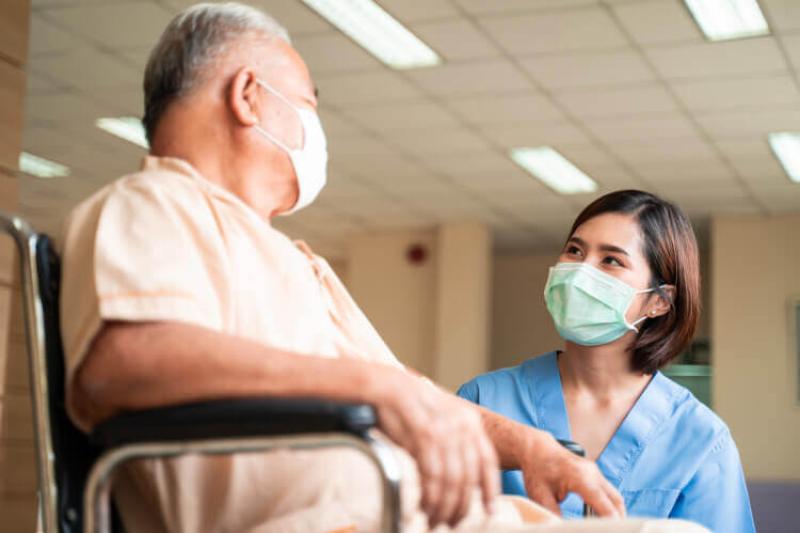- AdventHealth University

On any given day in a medical facility, the majority of registered nurses and nurse practitioners see three or more patients per hour. This means nurses can interact with some 36 to 48 patients in a single 12-hour rotation.
Not only that, a patient receiving care in an in-patient facility for several days may interact with up to 50 healthcare professionals and other hospital staff. Some of the many professionals who exchange information with one another include:
- Doctors
- Registered nurses
- Nurse practitioners
- Administrators
- Technologists
- Social workers
- Chaplains
- Other medical personnel
It’s essential that medical providers are on the same page when discussing and providing care for patients. It’s just as important for nurses and doctors to communicate with patients, to ensure they understand their treatment plans, test results, and diagnoses.
Because nurses are constantly and quickly interacting with both colleagues and patients — and lives are often on the line — effective communication is paramount.
Here are some helpful tips, tools, strategies, and resources for nursing students and current nurses who are looking to understand and improve nurse communication styles.
Why Is Nurse Communication Important?
One of the primary reasons nurse communication is important is that the well-being of patients is at stake. Poor communication can lead to medical errors or wasted time.
Research studies measure the impact of medical errors and miscommunication on patients’ lives, including the following:
- National Center for Biotechnology Information: According to a report from StatPearls, approximately 400,000 hospitalized patients experience some type of preventable harm annually. Medical errors in clinics and hospitals cause about 100,000 deaths each year. Diagnostic errors result in injury or death in some 40,000 to 80,000 patients annually.
- HIPPA Journal: In one study conducted by CRICO Strategies, safety experts found that 7,000 out of 23,000 analyzed medical malpractice lawsuits were caused by communication errors, and about 2,000 patient deaths resulted from communication failures.
Leading causes of miscommunication include the following:
- Diagnostic errors
- Verbal communication errors
- Written communication errors
- Tubing misconnection
- Medication errors
- Falls
- Device and equipment errors
- Information technology and electronic health records errors
- Infection
Examples of Miscommunication
Miscommunication can have a huge impact on many healthcare situations, and it can even lead to patient death.
For example, in a case reported by StatNews, a diabetic patient reached out to their medical provider’s office for help, but the nurses on staff never communicated this to the primary care provider. The patient later died from a lack of insulin.
In another example from StatNews, a patient told their nurse they were experiencing pain after surgery. The nurse also noted that the patient’s level of red blood cells had dropped. However, the nurse never reported what was going on to the surgeon, and the patient died of internal bleeding.
While no one person or circumstance was entirely responsible for the deaths of these two patients, avoiding communication breakdowns could have changed the outcomes of the situations.
Tips for Nursing Communication
Nurse practitioners, registered nurses, and nursing students can all benefit from developing effective communication practices. It can help them excel during their work day, as well as in nursing school clinical rotations as they prepare for real-world challenges.
Here are a few tips that can help nurses:
Tip #1: Use Oral Communication Effectively
A nurse’s main priority should always revolve around the health and well-being of patients. Nurses should directly and clearly communicate difficult and even commonplace information with kindness, precision, and empathy in all situations. Orally communicating information with a patient about their condition, disease, or diagnosis is essential.
Nurses frequently use oral communication when discussing important matters with:
- Doctors
- Administrators
- Other nurses
- Families of patients
Making sure everyone is on the same page about a certain treatment topic or key piece of patient information is vital. This involves good oral communication between all stakeholders, including patients, doctors, and other nurses.
Tip #2: Implement Written Communication
Nurses often find it useful to communicate in writing, and this form of communication can head off misunderstandings. For instance, if a patient doesn’t fully understand how to follow their treatment plan or how to take a medication, a nurse can give them written notes with details.
A nurse can also supply patients with printed or online educational tools, such as a pamphlet or website about healthy eating. The patient can then refer to this information repeatedly, whenever they need to.
Written communication between nurses is also important. Suppose a nurse’s shift is about to end, and another nurse is coming in to help a patient. The nurse who is going off duty can leave information — either in an electronic records system or paper log — about how the patient is doing and what they will need.
Tip #3: Actively Listen
While nurses verbally communicate essential information to patients and patients’ families, and they verbally interact with doctors on a daily basis, talking constitutes only about half of the effective communication equation.
To fully understand a situation, a nurse should actively listen to others. Active listening means engaging in a conversation with a patient, making eye contact with them, pausing to listen, hearing what the patient is saying, and actively doing something about it — whether that means orally responding or taking action.
Paying attention and listening can help a nurse gain a patient’s trust. For instance, if a nurse is kind and empathetic, a patient may open up to them about being in an abusive relationship. As a medical professional, the nurse could conduct an exam to check for any external or internal injury, connect the patient with a social worker, or even serve as an expert witness in a legal proceeding. If the nurse had not taken time to actively listen to the patient, the patient might not have received help.
Tip #4: Show Cultural Awareness
Another important tip for improving nurse communication is to demonstrate cultural awareness. Patients have unique experiences and come from different backgrounds and cultures. Here are some situations where patients can benefit from a nurse’s cultural awareness:
- Because of their cultural background, a female patient may feel more comfortable interacting with another female about certain issues, such as pregnancy or menopause.
- A patient who speaks a language other than English may ask a family member or friend to interpret for them. They can also ask for a nurse or medical translator that can speak their native language.
- A patient may decline certain procedures, medications, or treatments for religious or cultural reasons.
While a nurse who is communicating with a patient can present options, it’s ultimately up to the patient to make their own decisions — all communications between nurses and patients should respect that boundary. In addition, nurses can encourage patients to communicate their own preferences frankly, without fear of being dismissed. For instance, a nurse can recommend a course of action, but a patient has the right to accept that recommendation or not.
Any written or oral communication from nurses should show respect for, and understanding of, a patient’s right to disagree.
When communicating, nurses should always be sensitive of patients’ backgrounds, religions, and cultures, and not make generalizations or assumptions about what medications or treatments patients might prefer. Nurses should always exhibit cultural awareness by understanding possible cultural influences. They should refrain from expressing bias in their notes, in discussions with others about the patient, and in their remarks directly to patients.
Tip #5: Use Nonverbal Communication
While verbal and written communication with patients is key, nonverbal communication can be just as important.
Research studies from the 1960s to the present have reached different conclusions about what percentage of human communication is nonverbal. However, most studies argue that approximately 70-93% of communication is nonverbal.
Examples of nonverbal communication include the following.
- Facial expressions
- Tone
- Hand gestures
- Head movements
- Posture
- Physical distance between people
- Fidgeting
Here are some ways in which nurses can use nonverbal communication to make patients feel comfortable:
- Making eye contact with a patient and smiling
- Speaking clearly to a patient and using a gentle tone
- Making a patient feel comfortable by standing a certain distance away (respecting personal space) and having a relaxed but professional posture
Tools for Improving Communication in Nursing
Specific tools can help nurses with practical aspects of improving their communication skills and strategies.
Notebooks and Charting Books
One practical tool nurses can implement in their daily shifts is using notebooks and charting books. Nurses can write down their concerns about patients or their families and discuss them with other nurses or those in management roles.
Charting books help nurses keep track of physical and mental changes in a patient. Nurses use charting books to note when they check on patients and administer medication. They then have records of any changes in mood or symptoms. These notes can then be transcribed into the patient’s electronic medical record, making it accessible to other medical professionals.
Call Lights
Call lights are a tool that facilitate ongoing and immediate communication between nurses and patients. When a nurse needs something or has an emergency situation, they can use a call light to gain the attention of other nurses or summon help. Additionally, patients can use call lights for the same reasons: to gain attention or help from their on-call nurse.
SBAR
This tool is helpful when sharing information about patients with other nurses during a shift change. The SBAR acronym stands for:
- Situation: Nurses identify themselves, their patient, the unit, and the room number
- Background: Nurses provide an overview of the patient’s condition, including their diagnosis, medical history, medication, allergies, and designated doctor
- Assessment: Nurses briefly analyze the patient’s background, providing lab results or other relevant pieces of information
- Recommendation: Nurses make a recommendation or request for the next nurse that is taking over care of the patient
Strategies for Better Nurse Communication
Becoming a more effective nurse communicator doesn’t happen overnight. However, nurses can implement some of the following strategies to positively change their communication with patients, doctors, and other nurses.
Strategy #1: Develop Presentation Skills
One reason nurses may communicate information incorrectly may be due to a lack of confidence. If a nurse experiences high levels of stress or anxiety when it comes to sharing information, they might not communicate in a clear or concise way.
Developing presentation skills by sharing information with other nurses in low-stakes environments can help nurses prepare for information sharing in stressful situations.
Strategy #2: Use Clear and Concise Language
In some situations, a nurse may leave a message for a doctor that is unclear or ambiguous regarding a patient’s labs, test results, blood pressure, and beyond. As a consequence, the patient’s doctor (who may be visiting more than 20 or so patients that day) may not understand whether a patient has already gone through a procedure or what the results were.
In turn, lack of clarity can cause a doctor to waste time tracking down correct information. This can be detrimental to a patient’s health, especially if the medical situation at hand is time-sensitive. When communicating via hand written notes, a nurse should use handwriting that is clearly legible. When communicating orally, a nurse should speak clearly and audibly and check for understanding.
For both written and verbal communication regarding a patient, it’s essential that nurses use clear, concise, readable, and intelligible language.
Strategy #3: Choose a Communication Avenue
Another important strategy for improving communication is choosing the correct mode: verbal, written, or digital. Examples of modes and messages include:
- Verbally relaying a message
- Writing a memo
- Digitally inputting information on a patient’s electronic health record
In some situations, it may be best for a nurse to orally communicate with a patient’s doctor or other medical staff. Clearly, in an emergency, a nurse will orally communicate a patient’s condition while rushing with the doctor to an operating room, rather than taking the time to write a formal note.
Sometimes, written communication is best. If a doctor is busy and might easily overlook details about a patient, it’s usually better for the nurse to write a memo and pass it along to the doctor.
Another way nurses and doctors communicate with one another about patients is through electronic health records. Inputting detailed information — both important and commonplace — is essential. Having a comprehensive electronic health record helps medical professionals who will read it in the future. Electronic health records are a crucial communication tool, because they create a permanent record of a patients’ medical history, medications, diagnoses, and treatment plans.
Other Resources for Nurses
Just as patients are unique and have different experiences, nurses come from different backgrounds and have different ways of approaching their work. Those who may have difficulty communicating with patients and other healthcare professionals can consider exploring additional resources.
Resources for Improving Nurse Communication
Here are some studies and articles about nurse communication for nurses who wish to learn more about how to communicate on the job:
National Center for Biotechnology Information: This study by Nursing Open aims to demonstrate that professional communication between a nurse and patient has a significant role in patient satisfaction.
Nurse Choice: This article discusses 10 communication skills that can help nurses succeed in the medical field and provides examples of each.
International Journal of Nursing Sciences: This study seeks to identify strategies that would improve communication between nurses and physicians to provide evidence for practical improvement in the ICU, and ultimately improve patient outcomes.
American Hospital Association (AHA): The AHA offers evidence-based tools and resources on improving communication in nursing by examining several studies.
Explore the Benefits of Nurse Communication
Effective communication strategies can improve the overall quality of patient care and the excellence of a medical facility. Nurses can directly enhance the experience of patients by communicating with them, their family members, other nurses, physicians, and administrators.
Clear and concise verbal and written communication can potentially lead to fewer cases of patient deaths from miscommunication.
Productive communication can also lead to a more enjoyable work environment. When nurses collaborate with one another — sharing notes and working together to help patients — their job satisfaction can increase.
The process of becoming a nurse can be challenging; however, it can also be incredibly rewarding. By implementing effective nurse communication strategies in the workplace, nurses can improve the well-being of patients while pursuing a fulfilling career.


